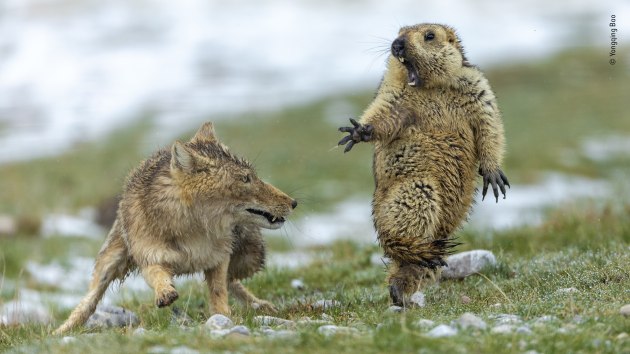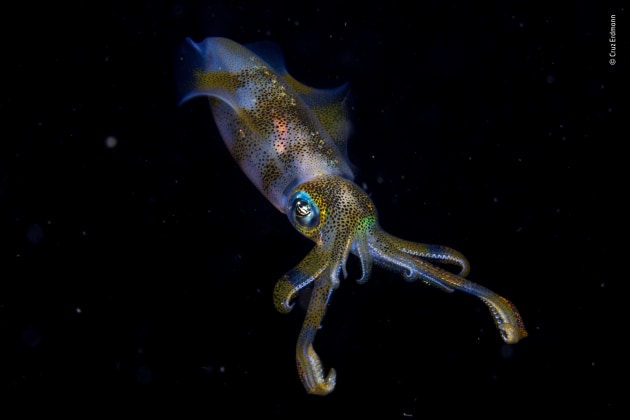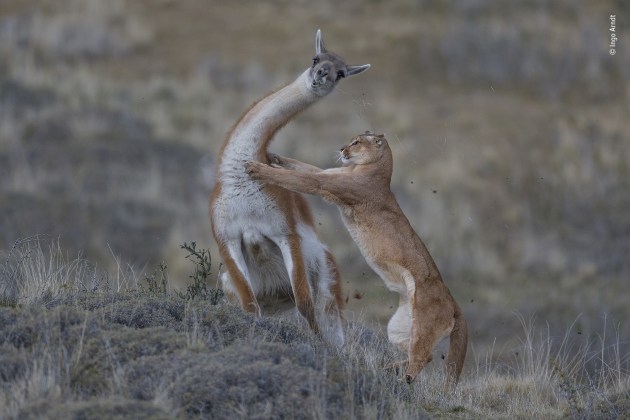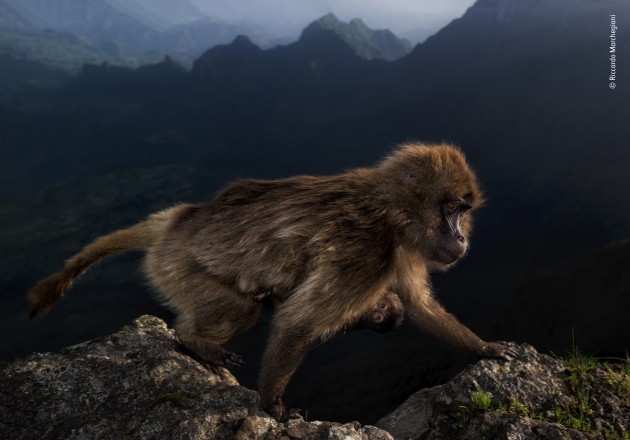Greatest wildlife images of 2019 revealed
The winners of the 55th annual Wildlife Photographer of the Year competition were recently revealed at a ceremony at the Natural History Museum, London. The overall winner, Yongqing Bao, from China, took out the title of Wildlife Photographer of the Year 2019 for his image, The Moment . It captures the standoff between a Tibetan fox and a marmot, seemingly frozen in life-or-death deliberations.
Wildlife Photographer of the Year 2019 and Joint Winner 2019, Behaviour: Mammals. © Yongqing Bao (China). The moment . It was early spring on the alpine meadowland of the Qinghai–Tibet Plateau, in China’s Qilian Mountains National Nature Reserve, and very cold. The marmot was hungry. It was still in its winter coat and not long out of its six-month, winter hibernation, spent deep underground with the rest of its colony of 30 or so. It had spotted the fox an hour earlier, and sounded the alarm to warn its companions to get back underground. But the fox itself hadn’t reacted, and was still in the same position. So the marmot had ventured out of its burrow again to search for plants to graze on. The fox continued to lie still. Then suddenly she rushed forward. Chair of the judging panel, Roz Kidman Cox, said: “Photographically, it is quite simply the perfect moment. The expressive intensity of the postures holds you transfixed, and the thread of energy between the raised paws seems to hold the protagonists in perfect balance. Images from the Qinghai-Tibet Plateau are rare enough, but to have captured such a powerful interaction between a Tibetan fox and a marmot – two species key to the ecology of this high-grassland region – is extraordinary.”
The title of Young Wildlife Photographer of the Year 2019 was taken out by fourteen-year-old Cruz Erdmann for a portrait of an iridescent big fin reef squid captured on a night dive in the Lembeh Strait off North Sulawesi, Indonesia.
Winner 2019, 11-14 years old. © Cruz Erdmann (New Zealand). Night glow . Cruz was on an organized night dive in the Lembeh Strait off North Sulawesi, Indonesia and, as an eager photographer and speedy swimmer, had been asked to hold back from the main group to allow slower swimmers a chance of photography. This was how he found himself over an unpromising sand flat, in just 3 metres (10 feet) of water. It was here that he encountered the pair of big fin reef squid. They were engaged in courtship, involving a glowing, fast‑changing communication of lines, spots and stripes of varying shades and colours. One immediately jetted away, but the other – probably the male – hovered just long enough for Cruz to capture one instant of its glowing underwater show. A member of the judging panel and nature photographer, Theo Bosboom, said of the image: “To dive in the pitch dark, find this beautiful squid and to be able to photograph it so elegantly, to reveal its wonderful shapes and colours, takes so much skill. What a resounding achievement for such a young photographer.’
The two Grand Prize winners were selected from the 19 category winners, and went on to beat over 48,000 entries from 100 countries. The winning images, along with 98 other photographers, will be on display at the Natural History Museum before touring across the UK and internationally to locations including Australia, Canada, Spain, the USA, and Germany.
Wildlife Photographer of the Year is developed and produced by the Natural History Museum, London.
Winner 2019, Behaviour: Birds. © Audun Rikardsen (Norway). Land of the eagle. High on a ledge, on the coast near his home in northern Norway, Audun carefully positioned an old tree branch that he hoped would make a perfect golden eagle lookout. To this he bolted a tripod head with a camera, flashes and motion sensor attached, and built himself a hide a short distance away. From time to time, he left road kill carrion nearby. Very gradually – over the next three years – a golden eagle got used to the camera and started to use the branch regularly to survey the coast below. Golden eagles need large territories, which most often are in open, mountainous areas inland. But in northern Norway, they can be found by the coast, even in the same area as sea eagles. They hunt and scavenge a variety of prey – from fish, amphibians and insects to birds and small and medium-sized mammals such as foxes and fawns. About the winners
Yongqing Bao
A native Tibetan from the Chinese province of Qinghai, raised on the Tibetan Plateau, Yongqing Bao is a wildlife photographer, publishing in newspapers and magazines in China. He trained as an ecologist and serves as the director and chief ecological photographer of the Qilian Mountains Nature Conservation Association of China.
Cruz Erdmann
Born and raised in Bali, Indonesia, but now living in New Zealand, 14-year-old Cruz Erdmann fell in love with the ocean at an early age, receiving his diver certification at 10. He has now logged nearly 200 dives. He inherited his father’s old underwater camera a year ago and has been taking pictures ever since. Now 13, his sights are set on becoming a helicopter pilot, involved with exploration or research, or a photographer working in remote areas.
Winner 2019, Wildlife Photographer of the Year Portfolio Award. © Stefan Christmann (Germany). The huddle , is part of a winning photo story. More than 5,000 male emperor penguins huddle against the wind and late winter cold on the sea ice of Antarctica’s Atka Bay, in front of the Ekström Ice Shelf. Each paired male bears a precious cargo on his feet – a single egg – tucked under a fold of skin (the brood pouch) as he faces the harshest winter on Earth, with temperatures that fall below -40˚C, severe wind chill and intense blizzards. The females entrust their eggs to their mates to incubate and then head for the sea, where they feed for up to three months. Physical adaptations – including body fat and several layers of scale-like feathers, ruffled only in the strongest of winds – help the males endure the cold, but survival depends on cooperation. The birds snuggle together, backs to the wind and heads down, sharing their body heat. Winner 2019, Urban Wildlife. © Charlie Hamilton James (UK). The rat pack . On Pearl Street, in New York’s Lower Manhattan, brown rats scamper between their home under a tree grille and a pile of garbage bags full of food waste. Their ancestors hailed from the Asian steppes, travelling with traders to Europe and later crossing the Atlantic. Today, urban rat populations are rising fast. The rodents are well suited for city living – powerful swimmers, burrowers and jumpers, with great balance, aided by their maligned long tails. They are smart – capable of navigating complex networks such as sewers. They are also social and may even show empathy towards one another. But it’s their propensity to spread disease that inspires fear and disgust. Attempts to control them, though, Winner 2019, Under Water. © David Doubilet (USA). The garden of eels. The colony of garden eels was one of the largest David had ever seen, at least two thirds the size of a football field, stretching down a steep sandy slope off Dauin, in the Philippines – a cornerstone of the famous Coral Triangle. He rolled off the boat in the shallows and descended along the colony edge, deciding where to set up his kit. He had long awaited this chance, sketching out an ideal portrait of the colony back in his studio and designing an underwater remote system to realize his ambition. It was also a return to a much-loved subject – his first story of very many stories in National Geographic was also on garden eels. These warm-water relatives of conger eels are extremely shy, vanishing into their sandy burrows the moment they sense anything unfamiliar. David placed his camera housing (mounted on a base plate, with a ball head) just within the colony and hid behind the remnants of a shipwreck. Joint Winner 2019, Behaviour: Mammals. © Ingo Arndt (Germany). The equal match . Fur flies as the puma launches her attack on the guanaco. For Ingo, the picture marked the culmination of seven months tracking wild pumas on foot, enduring extreme cold and biting winds in the Torres del Paine region of Patagonia, Chile. The female was Ingo’s main subject and was used to his presence. But to record an attack, he had to be facing both prey and puma. This required spotting a potential target – here a big male guanaco grazing apart from his herd on a small hill – and then positioning himself downwind, facing the likely direction the puma would come from. To monitor her movements when she was out of his sight, he positioned his two trackers so they could keep watch with binoculars and radio Ingo as the female approached her prey. A puma is fast – aided by a long, flexible spine (like that of the closely related cheetah) – but only over short distances. Winner 2019, Wildlife Photojournalist Story Award. © Jasper Doest (Netherlands). Show time is part of a winning photo story. For the past 17 years Riku, a Japanese macaque legally captured from the wild, has performed comedy skits three times a day in front of large audiences at the Nikkō Saru Gundan theatre north of Tokyo. These highly popular shows, which attract both locals and tourists, derive from Sarumawashi (translated as ‘monkey dancing’) – a traditional Japanese performance art that has been around for more than 1,000 years. The appeal of these contemporary performances lies in the anthropomorphic appearance of the trained macaques – invariably dressed in costumes – that move around the stage on two legs performing tricks and engaging in ridiculous role-plays with their human trainers. Photography is banned at shows, and so it took a long time for Jasper to gain Winner 2019, 15-17 years old. © Riccardo Marchgiani (Italy). Early riser . Riccardo could not believe his luck when, at first light, this female gelada, with a week-old infant clinging to her belly, climbed over the cliff edge close to where he was perched. He was with his father and a friend on the high plateau in Ethiopia’s Simien Mountains National Park, there to watch geladas – a grass eating primate found only on the Ethiopian Plateau. At night, the geladas would take refuge on the steep cliff faces, huddling together on sleeping ledges, emerging at dawn to graze on the alpine grassland. On this day, a couple of hours before sunrise, Riccardo’s guide again led them to a cliff edge where the geladas were likely to emerge, giving him time to get into position before the geladas woke up. Winner 2019, Animal Portraits. © Ripan Biswas (India). Face of deception . It may look like an ant, but then count its legs – and note those palps either side of the folded fangs. Ripan was photographing a red weaver ant colony in the subtropical forest of India’s Buxa Tiger Reserve, in West Bengal, when he spotted the odd looking ant. On a close look, he realized it was a tiny ant mimicking crab spider, just 5 millimetres (1/5 inch) long. Many spider species imitate ants in appearance and behaviour – even smell. Infiltrating an ant colony can help a spider wanting to eat ants or to avoid being eaten by them or by predators that dislike ants. This particular spider seemed to be hunting. By reverse mounting his lens, Ripan converted it to a macro, capable of taking extreme close ups. Here, the lens was so close that the diminutive arachnid seems to have been able to see its reflection and is raising its legs as a warning. Winner 2019, Animals in Their Environment. © Shangzhen Fan (China). Snow-plateau nomads . A small herd of male chiru leaves a trail of footprints on a snow-veiled slope in the Kumukuli Desert of China’s Altun Shan National Nature Reserve. These nimble antelopes – the males with long, slender, black horns – are high-altitude specialists, found only on the Qinghai–Tibet Plateau. To survive at elevations of up to 5,500 metres (18,000 feet), where temperatures fall to -40˚C (-40˚F), they have unique underfur – shahtoosh (Persian for ‘king of wools’) – very light, very warm and the main reason for the species’ drastic decline. A million chiru once ranged across this vast plateau, but commercial hunting in the 1980s and 1990s left only about 70,000 individuals. Rigorous protection has seen a small increase, but demand – mainly from the West – for shahtoosh shawls still exists. Sign up here .













